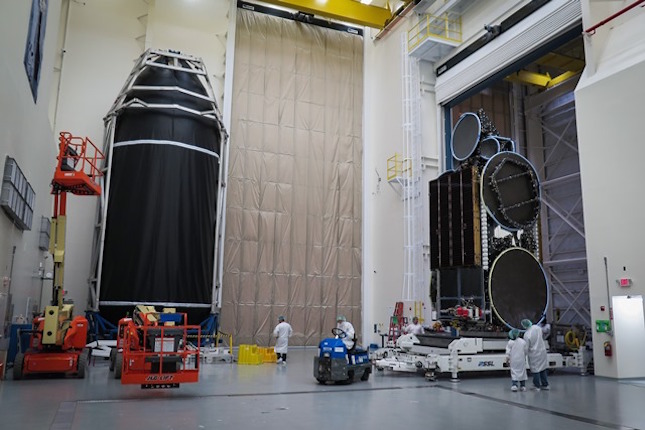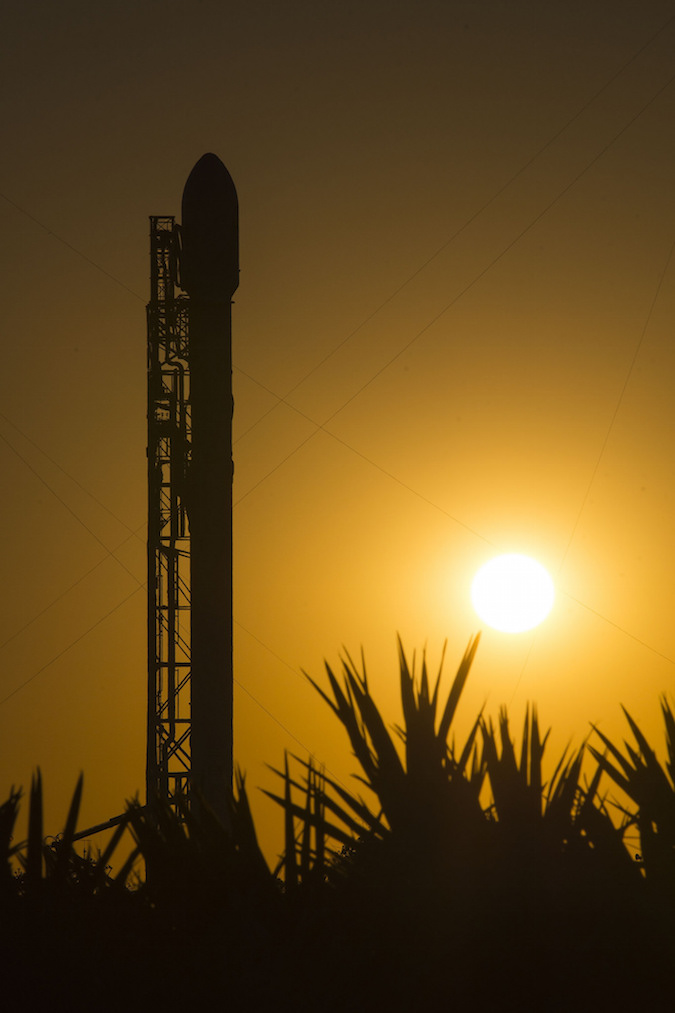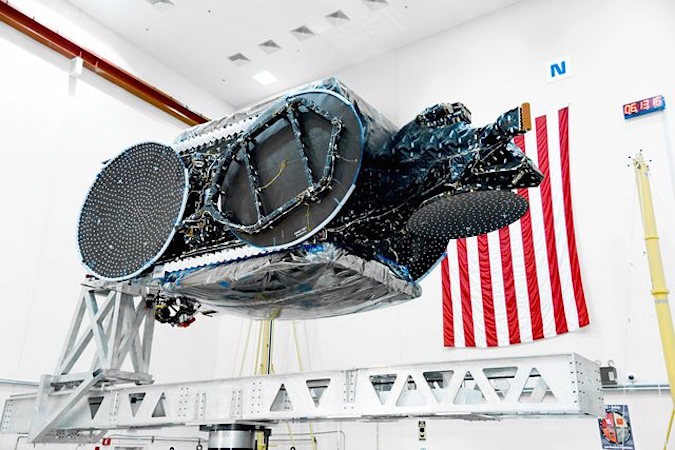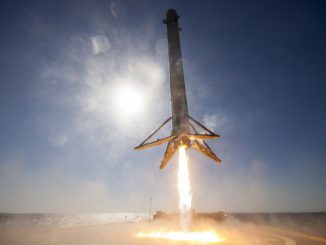
SpaceX is expected to transfer its next Falcon 9 rocket to launch pad 39A at NASA’s Kennedy Space Center in Florida on Monday with a direct-to-home television broadcast satellite on-board, setting up for a two-and-a-half hour predawn launch window Tuesday.
The Falcon 9 rocket will ride a heavy-duty transporter-erector system for the quarter-mile (400-meter) rollout from a horizontal assembly hangar at the southern edge of pad 39A. The carrier, which doubles as an umbilical mast during launch countdowns, will hydraulically hoist the 229-foot-tall (70-meter) rocket upright once it arrives at the top of the incline leading to the pad.
SpaceX will verify connections between the transporter-erector strongback and ground supplies of propellant, power and other systems needed during Monday night’s launch countdown.
Since Thursday, when the Falcon 9 rocket performed a hold-down engine firing at pad 39A, engineers returned the launcher to its hangar and attached a U.S.-owned commercial communications on its way to space to provide television broadcast services across Brazil.
The EchoStar 23 satellite was already encapsulated inside the Falcon 9’s payload fairing after being fueled and prepared for liftoff inside a nearby clean room facility.
The Falcon 9 launch conductor will poll the launch team for a “go” for fueling of the two-stage rocket at 12:16 a.m. EDT (0416 GMT), followed by the start of tanking with RP-1 kerosene fuel around eight minutes later.
Super-chilled liquid oxygen propellant, cooled to near its freezing point, will begin pumping into the Falcon 9 at T-minus 45 minutes.
The computer-controlled countdown will prep the rocket’s nine Merlin 1D main engines for ignition, transition the Falcon 9 to internal battery power, and pressurize the booster’s propellant tanks in the last 10 minutes of the countdown.
The launch window Tuesday opens at 1:34 a.m. EDT (0534 GMT) and runs until 4:04 a.m. EDT (0804 GMT).

Officials will be watching the weather during Tuesday morning’s launch window, with forecasters predicting mostly cloudy skies and isolated rain showers in the forecast.
The weather outlook issued by the U.S. Air Force’s 45th Weather Squadron on Sunday calls for a 60 percent chance that conditions will be favorable for a launch. A weather system over Florida was triggering scattered rain showers over the Space Coast and adjacent waters of the Atlantic Ocean late Sunday.
“This system will be very slow to transit Central Florida, keeping cloud cover and isolated showers over the Space Coast through the day on Monday,” the Air Force weather team wrote in a forecast released Sunday.
Meteorologists believe weather conditions will improve overnight and throughout the launch window.
“The frontal boundary associated with the system should push south of the spaceport by Monday evening. This will allow the extensive cloud cover to begin diminishing and become shallower through the countdown. The primary weather concern for launch Tuesday morning will be lingering thick clouds that haven’t cleared through the spaceport area.”
The official forecast calls for scattered clouds at 3,000 feet and 12,000 feet, and a broken deck of clouds at 22,000 feet. Winds will be from the west at 15 to 20 mph, and the temperature at launch time should be around 64 degrees Fahrenheit.
Cooler conditions are on tap across the Space Coast later in the week. If the rocket is unable to take off Tuesday, there is an 80 percent chance of acceptable weather during the Falcon 9’s backup window Thursday morning.
After liftoff, the slender white launcher will pitch on an easterly course from Cape Canaveral atop more than 1.7 million pounds of thrust, heading over the Atlantic on the way to a high-altitude geostationary transfer orbit, the drop-off point for most large telecom satellites.
Its first stage engines will shut off and fall away around two-and-a-half minutes into the flight, and the Falcon 9’s single Merlin upper stage engine will ignite two times to deliver the EchoStar 23 satellite into its intended egg-shaped orbit.
The Falcon 9’s first stage booster will fall into the Atlantic without trying to land on SpaceX’s recovery ship. The heavyweight EchoStar 23 satellite requires all of the Falcon 9’s lift capacity, leaving no fuel leftover to attempt a powered descent and touchdown.
The rocket is stripped of the four landing legs usually fastened to the base of the first stage, the first time a Falcon 9 has launched without the landing gear since April 2015.

Diverging from the public disclosure practices by most commercial launch and satellite companies, SpaceX and EchoStar have not revealed the parameters — such as the altitude and inclination — of the orbit targeted on Tuesday’s flight.
But the orbit will likely range in altitude from a few hundred miles above Earth to approximately 22,300 miles (nearly 36,000 kilometers).
An EchoStar spokesperson also declined to provide the mass of the EchoStar 23 satellite, which was manufactured by Space Systems/Loral in Palo Alto, California. Based on the SSL 1300 satellite bus, EchoStar 23 was ordered by EchoStar Satellite Services in 2014 and is based on the spacecraft chassis originally built for the CMBStar mobile communications station, a venture into the Chinese market led by EchoStar and canceled in 2008.
The tri-band EchoStar 23 satellite is designed with flexibility, according to EchoStar, with the ability to carry out multiple types of missions. Its communications payload includes Ku-band, Ka-band and S-band transponders.
EchoStar 23’s first operating post in geostationary orbit will be along the equator at 45 degrees west longitude, once the spacecraft completes a series of burns with its own main engine to circularize its orbit from the initial transfer orbit reached by the Falcon 9.
The craft was originally supposed to launch by the end of 2016, in time to meet a licensing deadline from ANATEL, the Brazilian communications regulatory agency, that requires EchoStar 23 be in service by the end of June.
EchoStar says it will meet that deadline for the Ku-band spectrum, which the company intends to use for television broadcast services in Brazil. The operator has sought an extension on the Ka-band and S-band deadlines, EchoStar said in its annual report released Feb. 24.
The company said is still exploring options to use its Ka-band and S-band spectrum rights by the regulatory deadline in mid-2017.
Rippling delays in SpaceX’s launch manifest caused the slip in EchoStar 23’s liftoff after a Falcon 9 rocket exploded Sept. 1 on a launch pad at Cape Canaveral, grounding SpaceX missions more than four months.
Tuesday’s launch will the third SpaceX rocket flight since the launch operator resumed service Jan. 14 with a successful Falcon 9 blastoff from California with 10 Iridium communications satellites.
SpaceX dispatched a Dragon supply ship to the International Space Station on a Feb. 19 launch from Florida, the first time the company has flown from pad 39A, which it leases from NASA.
Launch pad 39A was the starting point for all of NASA’s Apollo moon landing missions, plus the majority of space shuttle flights, including the first and last launches in 1981 and 2011.
The launch of EchoStar 23 will be the 31st Falcon 9 flight overall since the privately-developed booster debuted in June 2010.
This week’s SpaceX mission marks the start of a busy few weeks of launch activity on Florida’s Space Coast.
Two United Launch Alliance rockets, a Delta 4 and an Atlas 5, are due for liftoff soon.
A Delta 4 rocket is scheduled to launch Friday, March 17, with the U.S. Air Force’s WGS 9 communications satellite built with funding from military partners in Canada, Denmark, the Netherlands, Luxembourg and New Zealand.
An Atlas 5 launcher is set for liftoff March 21 with a NASA-contracted, commercially-owned Orbital ATK Cygnus cargo carrier with supplies and experiments to the International Space Station.
SpaceX’s next launch, set for no earlier than March 27, will loft the SES 10 communications satellite for SES of Luxembourg. That mission will mark the first time SpaceX has launched a Falcon 9 powered by a previously-flown first stage, a major leap in the firm’s cost-cutting reusability initiative.
Email the author.
Follow Stephen Clark on Twitter: @StephenClark1.



